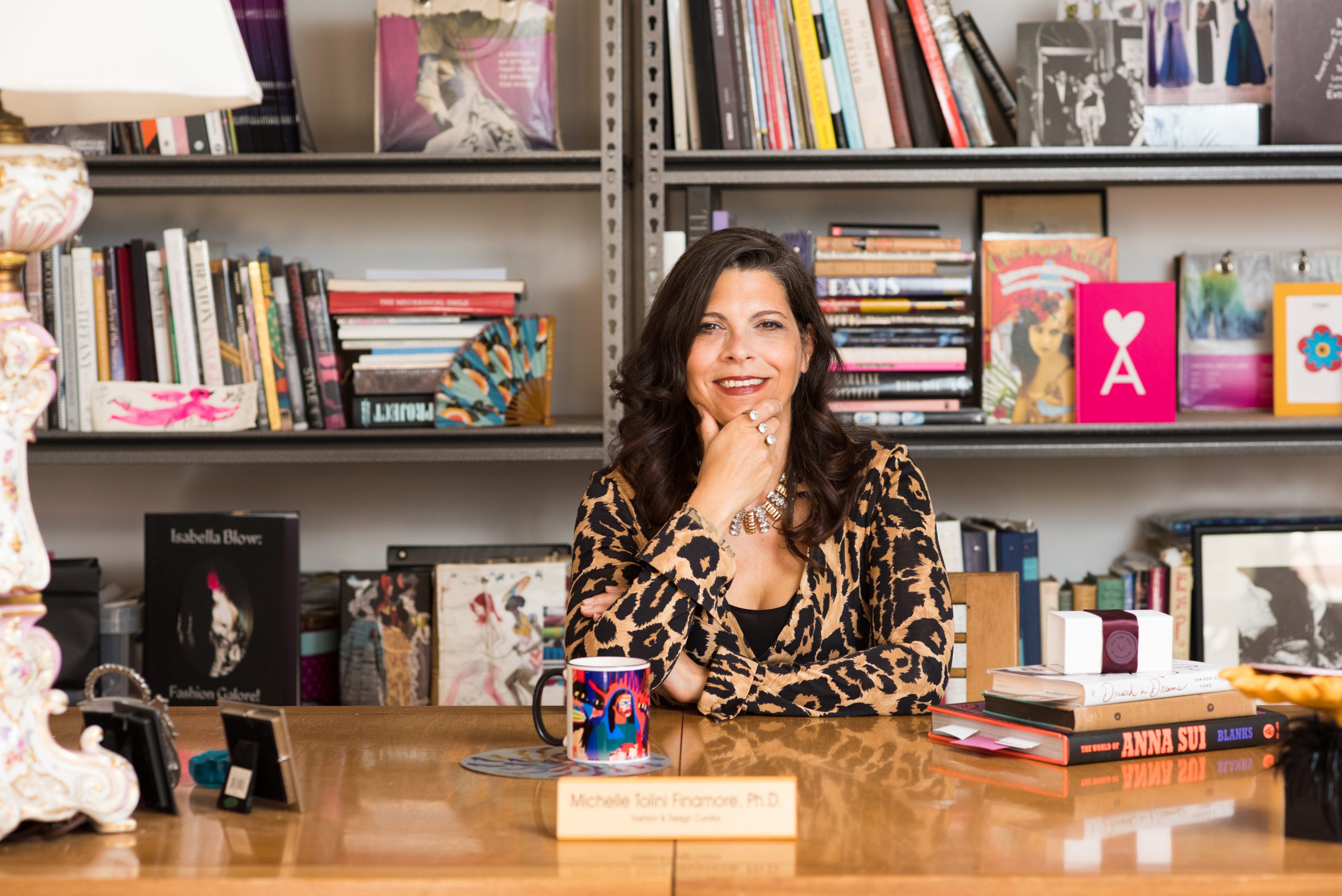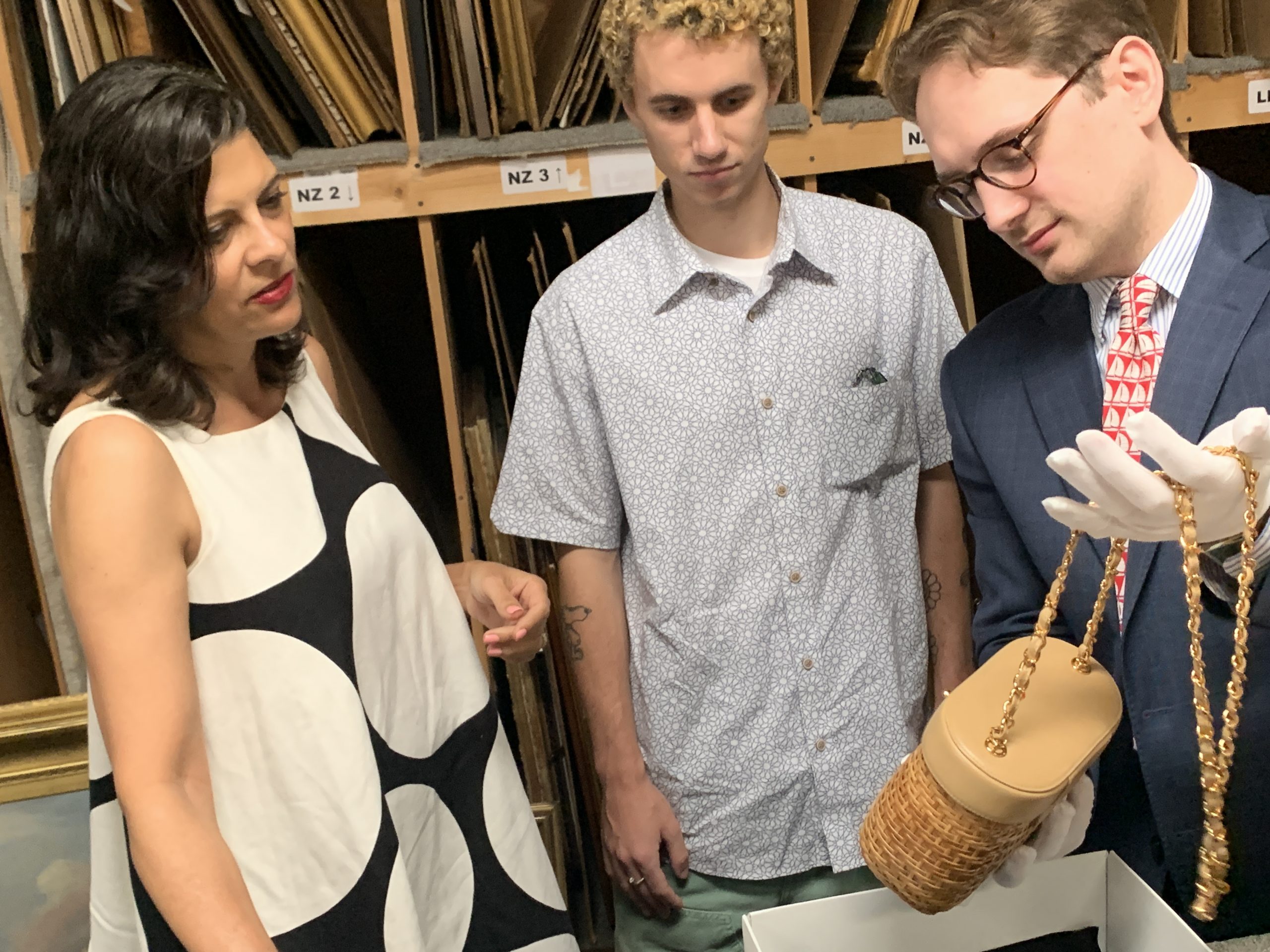Michelle Tolini Finamore Interview | August 16, 2023

Michelle Tolini Finamore (photo by Kim Indresano)
Michelle Tolini Finamore is a fashion historian and curator, her newest exhibition which started at Crystal Bridges Museum of American Art, Fashioning America: Grit to Glamour is traveling and has brought her through Asheville, North Carolina. Brunk Auctions was graciously given the opportunity to sit with her and discuss her life and career as well as get her input on the fashion world at large. Below is a transcript of the conversation between Mrs. Finamore, intern Zeke Davis, and luxury goods cataloger Jeffrey Johnson.

Is there anything about your job that might surprise people?
As someone who’s worked in fashion in the 20th and 21st centuries what are some similarities and differences between the two periods?
What do you see as the future of luxury goods and fashion in the museum sector and auction market?
I was just looking at Sotheby’s selling Tupac’s ring from the VMA Awards – the fact that these major auction houses have gone into Hip-Hop jewelry, for example, is incredible to me. I’ve always followed it, but I never thought it would become as big as it has. The sneaker sales, the luxury sneakers sales – it’s astonishing to me how much people will pay for some of those. We are seeing an elevation of Streetwear and American pop culture that has only intensified in recent years. You know, you go back to Warhol and so much of what he was doing in the 60s and 70s – we are seeing the full flowering of that. In terms of the luxury brands, one of the things that is really key to these big conglomerates like LVMH and Kering is that the handbags and the perfumes are their bread and butter. The couture clothes don’t make the money – it’s really the accessories. The luxury runway shows are really mostly just for show and marketing; there is an audience and clientele for that, but that is not really what drives their bottom line. Many people would rather invest in the accessories with logos, such as handbags, that they can have for 10 to 20 years. For this reason, items like the Hermes Birkin or a Chanel bag, which retain their style through the ever-changing fashion cycle, have seen a lot of growth in the auction world.
What do you think of the introduction and immersion of streetwear fashion in the couture world?
I think it’s enlivening it in many ways. I also think it’s really bringing this reality to what designers are creating, because I think so much of fashion has this element of fantasy, and that’s something I love about it as well. You know everyone wants to get lost in fantasy, but the reality is how many people are wearing those things? It’s a very limited market, so I think streetwear is addressing the way people really dress. We’ve also seen this extreme casual-ization of clothing and fashion generally, which I think there are a lot of reasons for, but I think one of them is the tech world, which is not focused on the suit and traditional business attire. If designers want to be seen as future-thinking, they have to respond to what people are wearing on the street.
Do you think streetwear is here to stay then?
You have a picture of Young Thug in an Alessandro Trincone dress on your website. Could you go into detail about why that is?
What makes an item worthy of exhibition?

Fashioning America
Some of that has changed in recent years – in any field, you get different areas of interest that surface over time and then decline. For fashion, it needs to tell a story about construction – it has to be something that is beautifully constructed, it has to have a designer behind it who’s very passionate about what they are creating, or it can tell a story about a wearer. You can look at it in various ways. It also depends on the type of museum – when you’re working at a fine arts museum, you’re really looking for the highest quality of craftsmanship. If you’re working in a social history museum, it’s a slightly different focus – you could get someone’s Girl Scout uniform and there’s this great story behind it and it still has value. So I think it really does depend on the context. For me, I always want the object to have a narrative that’s really compelling and can really tell you a story. It’s interesting because there’s been such a shift in focus in fashion history generally, so now there’s more appreciation for everyday wear, because people have not collected everyday wear. What women in the 1820s wore on the prairie, for example – those clothes weren’t saved and yet people now want to know what they are. With the expanding of the narrative in terms of people of color and black designers, there was never really a focus on that in fashion history pre-1970. So one of the things I’ve tried to do with Fashioning America is find the black dressmakers, Native American dressmakers, who were creating incredible fashions but haven’t been part of the traditional canon.
Has the recent introduction of AI and other technology as a method of design in art creation changed your perspective on fashion, or do you have an opinion on how it might affect the industry in the coming years?
Where do you go for inspiration for your exhibitions?
One of the things I love about contemporary fashion is that contemporary fashion designers are like contemporary artists, they respond immediately to what’s happening out there in the zeitgeist. With Gender Bending Fashion for example I noticed five or six years before this of great flowering of creativity and a questioning of gender boundaries that it was immediately evident on the runways. I think tracking what designers are doing and what they’re responding to really is an indication of where we will be going in the future. Just like contemporary artists, designers are on the edge and cusp of future trends – I love watching what they’re paying attention to.
Do you have any advice or words of wisdom for aspiring fashion designers?
Finally, what is one of your favorite pieces you’ve come across in your work as a curator of fashion arts?
Michelle Tolini Finamore’s interest in fashion came at a young age from her mother who owned a dress shop. Initially studying Art History, Michelle started working with fashion history at the Rhode Island School of Design in their fashion and textile department. She received her masters from the Fashion Institute of Technology, and her PHD from the Bard Graduate Center. During this time Michelle started working at the Museum of Fine Arts, Boston, where she would eventually come on as the Penny Vinik Curator of Fashion Arts; recently at the end of 2019 she went independent.
Michelle has done quite a few shows for the Museum of Fine Arts, Boston including Think Pink which was all about the gendered nature of the color pink in history through objects, garments, embroidery, and imagery, one on Hollywood Glamour, and Gender Bending Fashion which was about the history of gendered dress starting in the 19th century through the present. She has another show coming up at the Bard Graduate center on fashion in silent film.
Brunk Auctions is excited to present a fascinating collection of Luxury Goods in our upcoming September Premier & Emporium Auctions | September 14-16, 2023. Included among the selections are a Hermes Birkin 35 Cacao Handbag, a rare Chanel Wicker and Tan Leather Shoulder Bag, among a collection of items from the Estate of Donna Summer.
World-Class Consignments and Exceptional Results
